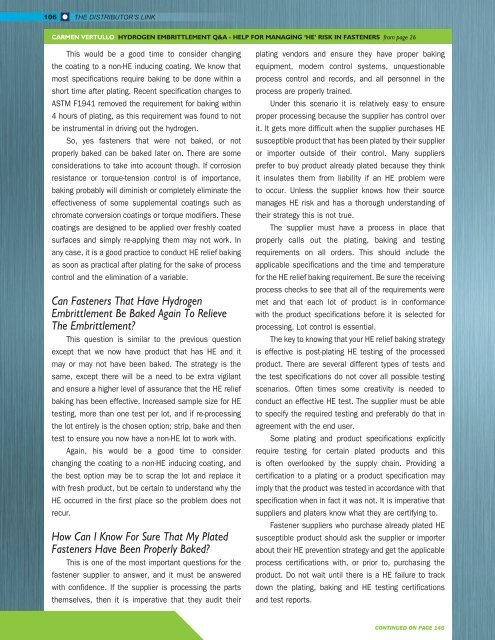SUMMER 2016
Distributor's Link Magazine Summer Issue 2016 / Vol 39 No3
Distributor's Link Magazine Summer Issue 2016 / Vol 39 No3
Create successful ePaper yourself
Turn your PDF publications into a flip-book with our unique Google optimized e-Paper software.
106<br />
THE DISTRIBUTOR’S LINK<br />
CARMEN VERTULLO HYDROGEN EMBRITTLEMENT Q&A - HELP FOR MANAGING ‘HE’ RISK IN FASTENERS from page 26<br />
This would be a good time to consider changing<br />
the coating to a non-HE inducing coating. We know that<br />
most specifications require baking to be done within a<br />
short time after plating. Recent specification changes to<br />
ASTM F1941 removed the requirement for baking within<br />
4 hours of plating, as this requirement was found to not<br />
be instrumental in driving out the hydrogen.<br />
So, yes fasteners that were not baked, or not<br />
properly baked can be baked later on. There are some<br />
considerations to take into account though. If corrosion<br />
resistance or torque-tension control is of importance,<br />
baking probably will diminish or completely eliminate the<br />
effectiveness of some supplemental coatings such as<br />
chromate conversion coatings or torque modifiers. These<br />
coatings are designed to be applied over freshly coated<br />
surfaces and simply re-applying them may not work. In<br />
any case, it is a good practice to conduct HE relief baking<br />
as soon as practical after plating for the sake of process<br />
control and the elimination of a variable.<br />
Can Fasteners That Have Hydrogen<br />
Embrittlement Be Baked Again To Relieve<br />
The Embrittlement?<br />
This question is similar to the previous question<br />
except that we now have product that has HE and it<br />
may or may not have been baked. The strategy is the<br />
same, except there will be a need to be extra vigilant<br />
and ensure a higher level of assurance that the HE relief<br />
baking has been effective. Increased sample size for HE<br />
testing, more than one test per lot, and if re-processing<br />
the lot entirely is the chosen option; strip, bake and then<br />
test to ensure you now have a non-HE lot to work with.<br />
Again, his would be a good time to consider<br />
changing the coating to a non-HE inducing coating, and<br />
the best option may be to scrap the lot and replace it<br />
with fresh product, but be certain to understand why the<br />
HE occurred in the first place so the problem does not<br />
recur.<br />
How Can I Know For Sure That My Plated<br />
Fasteners Have Been Properly Baked?<br />
This is one of the most important questions for the<br />
fastener supplier to answer, and it must be answered<br />
with confidence. If the supplier is processing the parts<br />
themselves, then it is imperative that they audit their<br />
plating vendors and ensure they have proper baking<br />
equipment, modern control systems, unquestionable<br />
process control and records, and all personnel in the<br />
process are properly trained.<br />
Under this scenario it is relatively easy to ensure<br />
proper processing because the supplier has control over<br />
it. It gets more difficult when the supplier purchases HE<br />
susceptible product that has been plated by their supplier<br />
or importer outside of their control. Many suppliers<br />
prefer to buy product already plated because they think<br />
it insulates them from liability if an HE problem were<br />
to occur. Unless the supplier knows how their source<br />
manages HE risk and has a thorough understanding of<br />
their strategy this is not true.<br />
The supplier must have a process in place that<br />
properly calls out the plating, baking and testing<br />
requirements on all orders. This should include the<br />
applicable specifications and the time and temperature<br />
for the HE relief baking requirement. Be sure the receiving<br />
process checks to see that all of the requirements were<br />
met and that each lot of product is in conformance<br />
with the product specifications before it is selected for<br />
processing. Lot control is essential.<br />
The key to knowing that your HE relief baking strategy<br />
is effective is post-plating HE testing of the processed<br />
product. There are several different types of tests and<br />
the test specifications do not cover all possible testing<br />
scenarios. Often times some creativity is needed to<br />
conduct an effective HE test. The supplier must be able<br />
to specify the required testing and preferably do that in<br />
agreement with the end user.<br />
Some plating and product specifications explicitly<br />
require testing for certain plated products and this<br />
is often overlooked by the supply chain. Providing a<br />
certification to a plating or a product specification may<br />
imply that the product was tested in accordance with that<br />
specification when in fact it was not. It is imperative that<br />
suppliers and platers know what they are certifying to.<br />
Fastener suppliers who purchase already plated HE<br />
susceptible product should ask the supplier or importer<br />
about their HE prevention strategy and get the applicable<br />
process certifications with, or prior to, purchasing the<br />
product. Do not wait until there is a HE failure to track<br />
down the plating, baking and HE testing certifications<br />
and test reports.<br />
CONTINUED ON PAGE 146

















